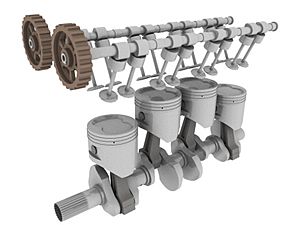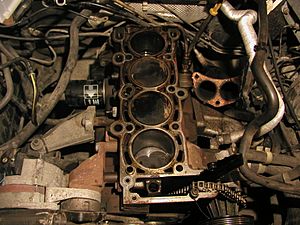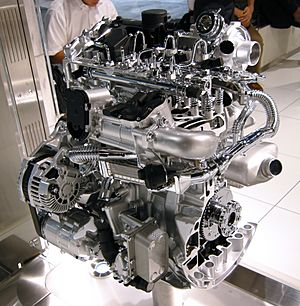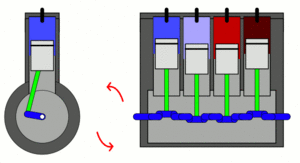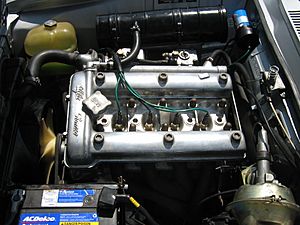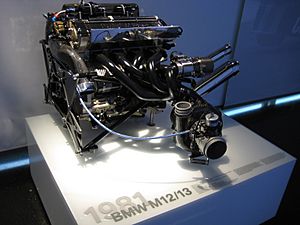Straight-four engine facts for kids
A straight-four engine (also called an inline-four) is a type of piston engine that has four cylinders arranged in a straight line. All these cylinders share one common crankshaft.
Most cars with four-cylinder engines use this straight-four design. It's also very common in motorcycles and other machines. So, when people say "four-cylinder engine," they usually mean a straight-four. If the engine is tilted instead of standing straight up, it's sometimes called a slant-four.
More and more cars are using four-cylinder engines. For example, between 2005 and 2008, the number of new cars sold in the United States with four-cylinder engines jumped from 30% to 47%. By 2020, this number was even higher, reaching 59% for light-duty vehicles.
Contents
How a Straight-Four Engine Works
A four-stroke straight-four engine is always working. This means that at any moment, at least one of its cylinders is pushing down to create power. Engines with fewer cylinders might have small pauses where no power is being made.
Compared to other four-cylinder engines like the V4 engine or flat-four engine, a straight-four engine only needs one cylinder head. This makes it simpler to build and often cheaper to produce.
Engine Size and Displacement
The size of an engine is measured by its "displacement." This is the total volume of air and fuel that all the cylinders can push.
Most straight-four petrol (gasoline) engines in modern cars have a displacement between 1.3 and 2.5 litres. However, some older engines were much larger, like the 1927–1931 Bentley 4½ Litre.
Diesel straight-four engines can be even larger. For example, some Mitsubishi and Toyota diesel engines have been 3.0 or 3.2 litres. Big trucks in Europe and Asia often use inline four-cylinder diesel engines around 5 litres. Even larger ones are found in trains, boats, and stationary machines.
On the other hand, some straight-four engines can be very small. In Japan, tiny cars called kei cars use small engines. Some of these engines had four cylinders even when they were limited to just 550 cc (cubic centimeters) in size. Today, the maximum size for kei car engines is 660 cc.
Engine Balance and Vibrations
Straight-four engines are designed so that their main parts move in a balanced way. This is because two pistons are always moving up while the other two are moving down at the same time. This helps keep the engine smooth.
However, straight-four engines can still have a small vibration. This happens because the pistons speed up and slow down differently when they are at the top or bottom of their travel. This creates a slight up-and-down shaking that happens twice as fast as the engine's spinning speed. This vibration is more noticeable in straight-four engines because all four pistons are working in pairs.
This vibration is usually small in engines with light pistons or those that don't spin very fast. But it can get stronger as the engine spins faster.
Power Delivery and Smoothness
Engines with five or more cylinders can deliver power very smoothly because at least one cylinder is always in its "power stroke." However, four-cylinder engines have tiny gaps in their power delivery. This means one cylinder finishes its power stroke just before the next one starts. These small pauses can cause a bit more vibration compared to engines with more cylinders.
Using Balance Shafts
To make larger straight-four engines smoother, some use a system called balance shafts. This system was invented a long time ago, in 1911. It uses two special shafts with weights on them. These shafts spin in opposite directions, twice as fast as the engine's crankshaft. This helps to cancel out the vibrations caused by the pistons.
Mitsubishi Motors patented a popular balance shaft system in the 1970s, and many other car companies have used it under license. Not all large straight-four engines have balance shafts, especially older ones or those designed to run at lower speeds.
Straight-Four Engines in Cars

Most modern straight-four engines in cars are between 1.5 and 2.5 litres in size. The smallest straight-four car engine was in the 1963–1967 Honda T360 mini-truck, which was only 356 cc. The largest mass-produced straight-four car engine was the 3.2-litre Mitsubishi 4M41 diesel engine, used in the Mitsubishi Pajero SUV.
Some important straight-four car engines include:
- 1954–1994 Alfa Romeo Twin Cam engine: This was one of the first engines with two camshafts (twin-cam) to be mass-produced. It was also one of the first to have variable valve timing, which helps the engine run better at different speeds.
- 1908–1941 Ford Model T engine: This engine powered the famous Ford Model T, one of the most widely produced cars in history.
- 1951–2000 BMC A-Series engine: This engine was special because it was the first to be used in a mass-produced car where the engine was placed sideways (transverse-engined) to power the front wheels.
- 2000–2009 Honda F20C engine: This engine was known for making a lot of power for its size, especially for an engine that didn't use a turbocharger.
Straight-Four Engines in Racing
Many early racing cars used straight-four engines. A very important one was the Peugeot engine that won the 1913 Indianapolis 500 race. This engine, designed by Ernest Henry, had double overhead camshafts (DOHC) and four valves per cylinder. This design became the standard for racing inline-four engines for a long time.
Other famous racing engines inspired by the Peugeot design include the Miller engine and later the Offenhauser engine. The Offenhauser engine was incredibly successful, winning the Indianapolis 500 five times in a row from 1971 to 1976.
After World War II, 1.5-litre straight-four engines with superchargers were used in early Formula One racing cars like the Maserati 4CL.
Another important racing engine was the straight-four Ferrari engine designed by Aurelio Lampredi. It started as a 2-litre engine for Formula 2 and grew to 2.5 litres for Formula One. For sports car races, its size was increased to 3.4 litres.
In the 1980s, Formula One racing was dominated by 1,500 cc turbocharged cars. The BMW M12/13 engine was famous for its high power. It used a regular car engine block and powered cars that won the world championship in 1983. The 1986 version of this engine was said to produce an amazing 1,300 horsepower during qualifying!
Straight-Four Engines in Motorcycles
The first motorcycles with inline-four engines were made by a Belgian company called FN Herstal in 1905. Their FN Four motorcycle had its engine mounted upright, running along the length of the bike. Other companies like Henderson and Indian also made motorcycles with this design.
Modern inline-four motorcycle engines became very popular with the Honda CB750 in 1969. Since then, the inline-four has become one of the most common engine types for street motorcycles. It's popular because it offers good performance for its cost.
Most major Japanese motorcycle makers, like Honda, Yamaha, Suzuki, and Kawasaki, offer motorcycles with inline-four engines. BMW also makes four-cylinder motorcycles.
The 2009 Yamaha R1 motorcycle has a special inline-four engine with a "crossplane" crankshaft. This design makes the engine feel smoother and helps riders control the bike better when sliding around corners during races.
Inline-four engines are also used in MotoGP by teams like Suzuki and Yamaha. For a while, the Moto2 racing class used 600 cc inline-four engines made by Honda.
See also
 In Spanish: Motor de cuatro cilindros en línea para niños
In Spanish: Motor de cuatro cilindros en línea para niños
- Flat-four engine
- V4 engine


